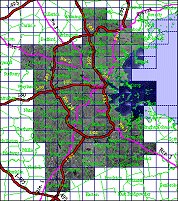 |
How to Build your Own Customized MITOrthoServer |
| This webpage provides you with step-by-step instructions for setting up and customizing your own MITOrthoServer, enabling you to provide your customers with easy access to your geospatial data via the Internet. | |
|
Since 1996, researchers in MIT's Urban Planning and Studies department have been developing tools to facilitate networked access to geospatial data. Their goal is to build smart servers (refered to as MITOrthoServers) that can provide customized snippets of digital orthophotos using just-in-time geoprocessing and interoperable web-based components. Because of their practicality, their ease-of-use and the increasing demand for digital orthoimagery, the servers became a success. To capitalize on this success, the researchers at MIT collaborated with other research parties nationawide and helped them build their own servers. check out Rhode
Island Ortho Server
As active participants in the OGC Web Mapping Testbeds, the researchers at MIT have also made sure that the protocols used in the MITOrthoServers' web interface comply with the latest (1.0) wmt specifiations issues by OGC (check the OGC web page for more details on the Web Mapping Testbeds and their published protocol specifications). The purpose of this webpage is to provide detailed instructions on the process of building customizable MITOrthoServers. MITOrthoServers are based on a set of components that serve large collections of geo-image libraries online, in a seamless, multi-resolution fashion. These components are available for others to use and modify, subject to the GNU Public License (GPL). Click below for instructions on how to After setting up your MITOrthoServer, you can use them with a variety of clients, including the following developed by the MIT researchers:
|
|